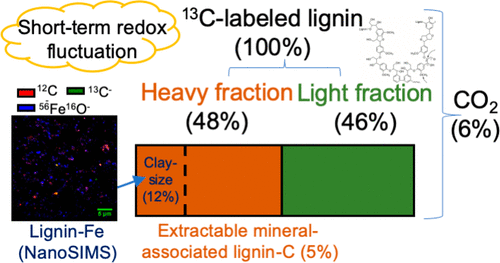当前位置:
X-MOL 学术
›
Environ. Sci. Technol.
›
论文详情
Our official English website, www.x-mol.net, welcomes your
feedback! (Note: you will need to create a separate account there.)
Enrichment of Lignin-Derived Carbon in Mineral-Associated Soil Organic Matter
Environmental Science & Technology ( IF 10.8 ) Pub Date : 2019-06-18 , DOI: 10.1021/acs.est.9b01834
Wenjuan Huang 1, 2 , Kenneth E. Hammel 3, 4 , Jialong Hao 5 , Aaron Thompson 6 , Vitaliy I. Timokhin 7 , Steven J. Hall 1
Environmental Science & Technology ( IF 10.8 ) Pub Date : 2019-06-18 , DOI: 10.1021/acs.est.9b01834
Wenjuan Huang 1, 2 , Kenneth E. Hammel 3, 4 , Jialong Hao 5 , Aaron Thompson 6 , Vitaliy I. Timokhin 7 , Steven J. Hall 1
Affiliation

|
A modern paradigm of soil organic matter proposes that persistent carbon (C) derives primarily from microbial residues interacting with minerals, challenging older ideas that lignin moieties contribute to soil C because of inherent recalcitrance. We proposed that aspects of these old and new paradigms can be partially reconciled by considering interactions between lignin decomposition products and redox-sensitive iron (Fe) minerals. An Fe-rich tropical soil (with C4 litter and either 13C-labeled or unlabeled lignin) was pretreated with different durations of anaerobiosis (0–12 days) and incubated aerobically for 317 days. Only 5.7 ± 0.2% of lignin 13C was mineralized to CO2 versus 51.2 ± 0.4% of litter C. More added lignin-derived C (48.2 ± 0.9%) than bulk litter-derived C (30.6 ± 0.7%) was retained in mineral-associated organic matter (MAOM; density >1.8 g cm–3), and 12.2 ± 0.3% of lignin-derived C vs 6.4 ± 0.1% of litter C accrued in clay-sized (<2 μm) MAOM. Longer anaerobic pretreatments increased added lignin-derived C associated with Fe, according to extractions and nanoscale secondary ion mass spectrometry (NanoSIMS). Microbial residues are important, but lignin-derived C may also contribute disproportionately to MAOM relative to bulk litter-derived C, especially following redox-sensitive biogeochemical interactions.
中文翻译:

矿物相关土壤有机质中木质素衍生碳的富集
现代的土壤有机质范式提出,持久性碳(C)主要来源于与矿物质相互作用的微生物残基,这挑战了木质素部分由于固有的顽固性而对土壤C产生贡献的古老观念。我们提出,可以通过考虑木质素分解产物与氧化还原敏感性铁(Fe)矿物之间的相互作用来部分调和这些新旧范式的各个方面。用不同持续时间的厌氧菌培养(0-12天)预处理富含铁的热带土壤(带有C 4垫料和13 C标记或未标记的木质素),并在需氧条件下培养317天。木质素13 C仅5.7±0.2%矿化为CO 2与51.2±0.4%的凋落物C相比。更多的木质素衍生的C(48.2±0.9%)比大量的凋落物衍生的C(30.6±0.7%)保留在矿物相关的有机物质(MAOM;密度> 1.8 g cm – 3),以及在粘土大小(<2μm)的MAOM中产生的木质素衍生的C的12.2±0.3%和凋落物C的6.4±0.1%。根据萃取和纳米级二次离子质谱(NanoSIMS),更长的厌氧预处理会增加与铁相关的木质素衍生C的添加。微生物残留很重要,但木质素衍生的C相对于散装垃圾衍生的C也可能对MAOM的贡献不成比例,尤其是在氧化还原敏感的生物地球化学相互作用之后。
更新日期:2019-06-19
中文翻译:

矿物相关土壤有机质中木质素衍生碳的富集
现代的土壤有机质范式提出,持久性碳(C)主要来源于与矿物质相互作用的微生物残基,这挑战了木质素部分由于固有的顽固性而对土壤C产生贡献的古老观念。我们提出,可以通过考虑木质素分解产物与氧化还原敏感性铁(Fe)矿物之间的相互作用来部分调和这些新旧范式的各个方面。用不同持续时间的厌氧菌培养(0-12天)预处理富含铁的热带土壤(带有C 4垫料和13 C标记或未标记的木质素),并在需氧条件下培养317天。木质素13 C仅5.7±0.2%矿化为CO 2与51.2±0.4%的凋落物C相比。更多的木质素衍生的C(48.2±0.9%)比大量的凋落物衍生的C(30.6±0.7%)保留在矿物相关的有机物质(MAOM;密度> 1.8 g cm – 3),以及在粘土大小(<2μm)的MAOM中产生的木质素衍生的C的12.2±0.3%和凋落物C的6.4±0.1%。根据萃取和纳米级二次离子质谱(NanoSIMS),更长的厌氧预处理会增加与铁相关的木质素衍生C的添加。微生物残留很重要,但木质素衍生的C相对于散装垃圾衍生的C也可能对MAOM的贡献不成比例,尤其是在氧化还原敏感的生物地球化学相互作用之后。































 京公网安备 11010802027423号
京公网安备 11010802027423号